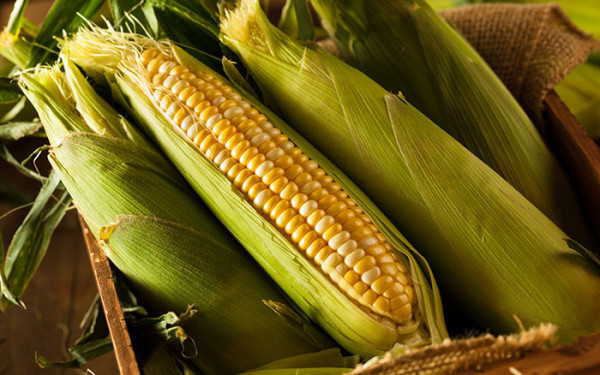Once you’ve experienced the juicy texture and sweet flavours of homegrown sweetcorn, you will never look back. There’s nothing like fresh sweetcorn straight into the pan, cooked and served with a knob of butter, it truly is delicious. Here’s a guide to growing sweetcorn in the garden.
Originally, corn was grown by Native American tribes, more than 7,000 years ago, they even used to use the leaves as chewing gum. Interestingly, sweetcorn occurs as a spontaneous mutation in the genes that control the conversion of sugar to starch. However, it first made its way to Europe in the 1770s, and from then it has become an incredibly popular veg. Sweetcorn was even voted as one of the top ten favourite vegetables in the UK. It’s not a surprise really, as the bright and cheery looking veg is versatile, nutritious, and tastes great.
Supply of sweetcorn
Not only will growing sweetcorn provide you with a yield of delicious corn, but whilst it is growing, the architectural plants bring height and an ornamental feature to your garden. Another plus is that the height means it also doubles as a windbreak through the summer months. Although they are sturdy and tend to support themselves when growing, it can be helpful to stake them individually to keep them upright and growing well.
A warm, sunny, and sheltered spot is best for sweetcorn. It grows best during long, hot summers, which explains why corn is grown on every continent except Antarctica. However, there are an abundance of varieties available to grow, some which are suited to the cooler temperatures of the UK.
If you are getting a head start, seeds can be sown indoors from mid-April to early May and must be kept at temperatures between 18-21˚C. For sowing outdoors, late spring is best when the soil is 10˚C above. When sowing outdoors, it’s best to sow in blocks instead of rows, spacing the plants around 45cm apart. This is because sweetcorn is wind pollinated meaning the wind carries the pollen from the tassel one plant which is the male part to the silks of the other, the female part. A light breeze can do this, but you can aid the process by tapping the top of the plants when the tassels open to push things along a little.

Care for your corn
Their large leaves mean they have high demand for water, so ensure they are watered well, especially during long, dry spells. To retain moisture, mulch the base of the plants which will also keep the roots cool whilst supressing weeds. Mulching and building soil around the base will also help to keep the plants stable and anchored into the ground.
When the plants begin to flower and the cobs start to swell up, feed the plants with a liquid fertiliser every 2 weeks up until harvesting.
You can tell if sweetcorn is ready to be harvested if the silks at the end have turned dark brown in colour. To check, you can do the fingernail test, where you press a kernel and see the colour of the liquid. If the liquid is watery, it’s not yet ripe but if the liquid has a creamier consistency then it’s ready to be picked. To harvest, give the cobs a sharp twist to release them. Try to pick the cobs immediately before you are planning to eat them to make the most of their sweet taste, because as soon as they are harvested, the sugar starts converting to starch and the sweetness will begin to disappear.

Steam your sweetcorn
There are many myths surrounding sweetcorn, even its classification can be argued. Put simply, when it’s fresh on the cob, sweetcorn is a vegetable. Whereas if the kernels are dry, it is a grain.
Sweetcorn is high in fibre, vital for out digestive system and is also helpful to make us feel fuller for longer. Another essential nutrient that is found in sweetcorn is magnesium which plays a role in metabolising food into energy and reducing tiredness, as well as potassium which helps muscles to relax and contract. The nutrients in sweetcorn make it a great food to eat after exercising.
It’s also a good source of vitamin C, a vitamin crucial for immune system function. To make the most of the vitamin C in this nutritious vegetable, it’s best to steam it because other methods of cooking can decrease the amount of the vitamin and therefore the effectiveness of the veg.
You can save your summer bounty by freezing the corn. First blanch the cobs for around 4 minutes to inactivate the enzymes, then place them in ice water for 4 minutes to stop the sweetcorn from becoming mushy. Drain the cobs, before cutting the kernels off the cob and sealing them in freezer bags and eat within a year of freezing. This process will keep the colour and nutrients intact.

Types of sweetcorn to try
As we know, we can’t always rely on a long, hot summer in the UK, so it’s handy to grow varieties of sweetcorn that can withstand cooler conditions too. Look no further than ‘Lark’ which is a fairly new, tendersweet variety. Each plant will produce two or three long cobs of soft sweetcorn. For an early maturing variety ‘Swift’ is an extra tender, supersweet variety with rich flavour, that will tolerate growing in cold soil.
Alternatively, try your hand at growing babycorn for sweet and crunchy veg that makes a lovely addition to a summer salad or stir-fry. Each ‘Minipop’ plant will produce four or five yellow babycorns. What’s more is you won’t need to worry about pollinating because you eat them before this happens – which also means you don’t need to grow them in blocks.


Leave A Comment